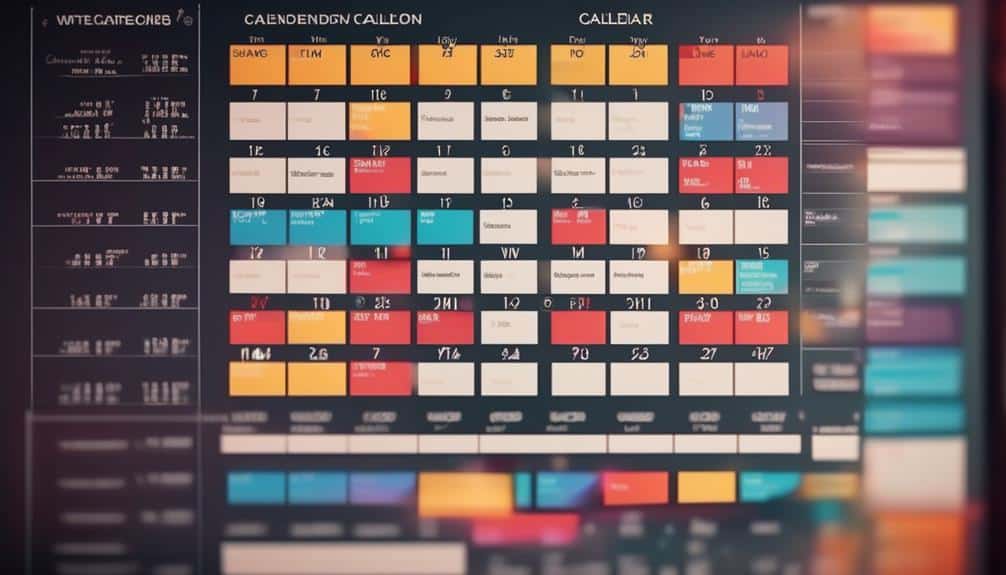Maximizing Your Content Strategy: Why You Need a Content Calendar
If you've ever found yourself scrambling to come up with fresh content ideas for your blog, social media, or email campaigns, you understand the struggle of maintaining a consistent online presence. Picture this: you're constantly juggling between brainstorming, creating, and sharing content, trying to keep up with your audience's demands for new information.
However, there's a solution that can help alleviate this content chaos and bring order to your strategy. By implementing a content calendar, you can not only stay organized but also unlock a myriad of benefits that will elevate your content game to the next level.
Interested to find out how?
Key Takeaways
- Enhance organization and productivity through content calendar implementation
- Prioritize content brainstorming based on relevance and alignment
- Utilize automation tools for efficiency in content creation
- Monitor industry trends and adapt content strategy for maximum impact
Benefits of a Content Calendar

Utilizing a content calendar in your strategy provides a structured framework that enhances organization, productivity, and overall effectiveness. By implementing a content calendar, you can significantly increase productivity within your content creation process. This tool allows you to plan and schedule your content in advance, ensuring a steady stream of materials without the stress of last-minute deadlines.
Furthermore, a content calendar enables you to optimize your content effectively. You can strategically plan the timing and frequency of your posts, ensuring consistency and relevance to your audience. By analyzing data and trends, you can tailor your content to align with what resonates most with your readers, thus maximizing engagement and impact.
In essence, a content calendar serves as a roadmap for your content strategy, guiding you towards your goals with increased efficiency and precision. It not only streamlines your workflow but also empowers you to create high-quality content that resonates with your target audience.
Organizing Your Content Ideas
To effectively organize your content ideas, categorize them based on themes and prioritize them according to relevance and strategic alignment. Start by employing various brainstorming techniques to generate a diverse range of ideas. Consider using methods like mind mapping, SWOT analysis, or the 5 Whys to delve deeper into potential topics.
Once you have a pool of ideas, categorize them into themes or topics that align with your overall content strategy. This step will help you see patterns and identify gaps that need to be filled.
After categorizing your ideas, prioritize them based on their relevance to your audience and strategic alignment with your business goals. Consider factors such as seasonality, trends, and the buyer's journey when determining the order in which to tackle each idea.
Enhancing Content Consistency

To achieve enhanced content consistency, focus on timely content scheduling and improved audience engagement.
By strategically planning your content calendar, you can ensure that your messaging is cohesive and aligned with your overall strategy.
Consistency in your content delivery can help build trust with your audience and keep them engaged with your brand.
Timely Content Scheduling
Consistently scheduling your content at the right times optimizes audience engagement and enhances overall content consistency. To achieve this, strategic content scheduling is crucial. By utilizing an editorial calendar effectively, you can prioritize your content based on relevance and timing, ensuring that your audience receives valuable information when they are most receptive. To help you visualize the impact of timely content scheduling, consider the following emotional aspects:
| Emotional Aspect | Description | Actionable Step |
|---|---|---|
| Anticipation | Building excitement | Create teaser campaigns |
| Connection | Fostering relationships | Reply to comments |
| Inspiration | Motivating action | Share success stories |
| Trust | Establishing credibility | Provide expert advice |
| Delight | Creating joy | Share behind-the-scenes |
Implementing these emotional triggers in your content calendar will enhance engagement and strengthen your content strategy.
Improved Audience Engagement
Enhancing audience engagement involves strategically aligning emotional triggers within your content calendar to ensure consistent and impactful interactions with your target audience. To increase interaction and audience retention, consider the following tactics:
- Implement personalized content to resonate with individual preferences.
- Utilize interactive elements like polls, quizzes, and surveys to engage users actively.
- Incorporate storytelling techniques to create a connection and evoke emotions.
- Encourage user-generated content to foster a sense of community and participation.
Improving Content Planning
How can you streamline your content planning process for maximum efficiency and impact? To enhance your content planning, start by prioritizing content brainstorming sessions to generate innovative ideas. Next, ensure you have a well-structured editorial calendar that outlines deadlines, content types, and distribution channels. This will help you stay organized and on track with your content creation timeline.
To further improve your content planning strategy, consider the following key elements:
| Key Elements | Benefits |
|---|---|
| Collaborative Tools | Encourages team collaboration and idea sharing |
| Data Analysis | Helps in understanding audience preferences |
| Content Pillars | Establishes themes for consistent messaging |
Streamlining Content Creation

To streamline your content creation process effectively, prioritize establishing clear guidelines for content development and production workflows. By increasing productivity and improving efficiency in your content creation efforts, you can achieve optimal results.
Here are key strategies to enhance your content creation workflow:
- Utilize Templates: Develop standardized templates for different types of content to expedite the creation process.
- Implement Automation Tools: Use automation tools for tasks like scheduling, posting, and tracking content performance.
- Conduct Regular Content Audits: Assess the effectiveness of your content regularly to identify areas for improvement and refinement.
- Encourage Collaboration: Foster collaboration among team members to brainstorm ideas, share insights, and streamline content creation processes.
Maximizing Content Distribution
Having established a streamlined content creation process, your next focus should be on optimizing the distribution of your content to maximize its reach and impact. Content promotion plays a vital role in ensuring that your carefully crafted content reaches the right audience at the right time. To enhance audience reach, consider utilizing a mix of distribution channels such as social media platforms, email newsletters, guest posting, and collaborations with influencers or industry partners.
When planning your content distribution strategy, it's crucial to align your efforts with your target audience's preferences and behavior. Analyze data from past campaigns to identify which channels have generated the most engagement and tailor your distribution approach accordingly. Experiment with different formats and posting schedules to keep your audience engaged and interested in your content.
Remember to monitor the performance of your distribution efforts regularly and make adjustments as needed to optimize your content's visibility and impact. By strategically promoting your content across various channels and adapting to your audience's preferences, you can significantly boost your content's reach and effectiveness.
Boosting Team Collaboration

Collaborate effectively with your team to enhance productivity and innovation within your content strategy. Improving efficiency and fostering creativity in your collaborative efforts can significantly impact the success of your content calendar.
Here are some key strategies to boost team collaboration:
- Regular Check-ins: Schedule frequent team meetings to discuss progress, share ideas, and address any challenges that may arise.
- Utilize Shared Platforms: Use collaborative tools like Google Drive or Trello to keep everyone on the same page and streamline communication.
- Encourage Open Communication: Create a culture where team members feel comfortable sharing their thoughts and ideas openly.
- Assign Clear Roles: Clearly define each team member's responsibilities to avoid confusion and ensure tasks are completed efficiently.
Tracking Content Performance
Tracking content performance is crucial for evaluating the effectiveness of your strategy and making data-driven decisions for future improvements. By utilizing content analytics and performance metrics, you can gain valuable insights into how your content is resonating with your audience. These tools provide you with quantifiable data on key performance indicators such as engagement rates, conversion rates, and traffic sources.
To effectively track content performance, start by defining clear objectives and key metrics that align with your overall content strategy. Establishing specific goals will help you measure success accurately. Regularly monitor your content analytics to identify trends, patterns, and areas for optimization. By analyzing this data, you can pinpoint what's working well and what may need adjustment.
Incorporating performance metrics into your content strategy allows you to iterate and refine your approach continually. By leveraging data-driven insights, you can make informed decisions to enhance the impact of your content and drive better results. Stay agile in your content planning and execution, using performance tracking as a guiding light towards achieving your strategic objectives.
Adapting to Changing Trends

To effectively navigate the ever-evolving landscape of content creation, it's imperative to proactively adjust your strategies in response to shifting trends. Staying agile in your approach and being quick to adapt is crucial to keep up with the rapid pace of content evolution.
Here are some key strategies to help you stay ahead of changing trends:
- Monitor Industry Trends: Regularly scan industry news and follow thought leaders to stay informed about the latest trends.
- Analyze Data: Utilize analytics tools to track the performance of your content and identify patterns that indicate emerging trends.
- Engage with Your Audience: Actively listen to feedback from your audience through comments, surveys, and social media interactions to understand their preferences.
- Experiment and Innovate: Don't be afraid to try new formats, topics, or platforms to test what resonates best with your audience and stay at the forefront of content trends.
Frequently Asked Questions
How Can a Content Calendar Help With SEO Optimization and Keyword Planning?
A content calendar enables you to strategically plan your SEO optimization and keyword planning efforts. It helps schedule link building activities, ensuring consistent and relevant content. By organizing your posts, you can align them with social media engagement for maximum impact.
What Are Some Common Pitfalls to Avoid When Implementing a Content Calendar?
To ensure success with content scheduling, focus on time management. Avoid common pitfalls by prioritizing consistency and engagement. Stay organized to maximize efficiency in your strategy. By implementing these tips, you'll elevate your content calendar game.
How Can a Content Calendar Be Used to Repurpose and Recycle Content Effectively?
To repurpose and recycle content effectively, utilize content repurposing techniques like turning blog posts into infographics, and employ content recycling strategies such as creating social media teasers from longer videos. Experiment with creative content ideas and engaging content formats.
What Tools and Software Are Recommended for Creating and Managing a Content Calendar?
To create and manage your content calendar effectively, utilize collaboration tools like Asana, Trello, or Google Sheets for seamless team coordination. Incorporate editorial calendars for content planning. For social media scheduling and analytics, consider platforms such as Hootsuite and Sprout Social.
How Can a Content Calendar Be Used to Align With Overall Business Goals and Objectives?
To align content with business goals effectively, utilize a content calendar. By mapping out content creation, distribution, and promotion in advance, you ensure that every piece contributes to overarching business strategy, enhancing alignment and maximizing impact.
Conclusion
In conclusion, implementing a content calendar is essential for maximizing your content strategy. It helps you stay organized, consistent, and efficient in planning and creating content.
By streamlining your process, boosting team collaboration, and tracking performance, you can adapt to changing trends and ensure your content remains relevant and impactful.
Don't underestimate the power of a well-planned content calendar in driving your content strategy to success.








